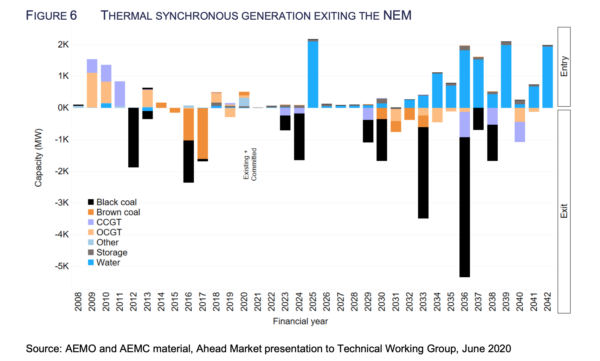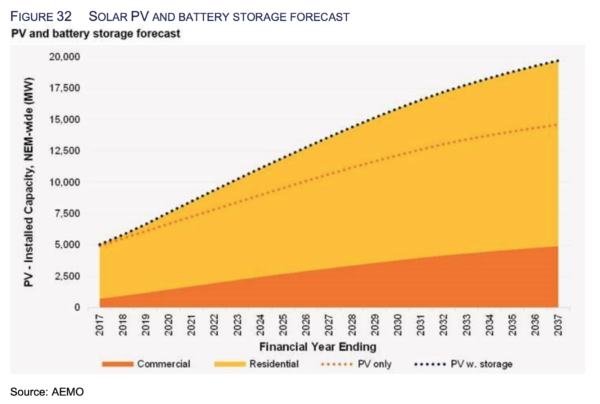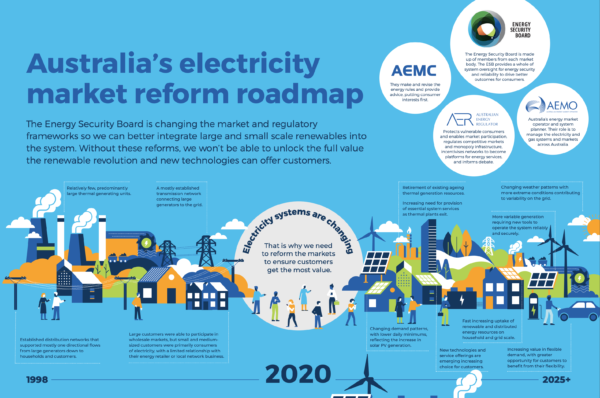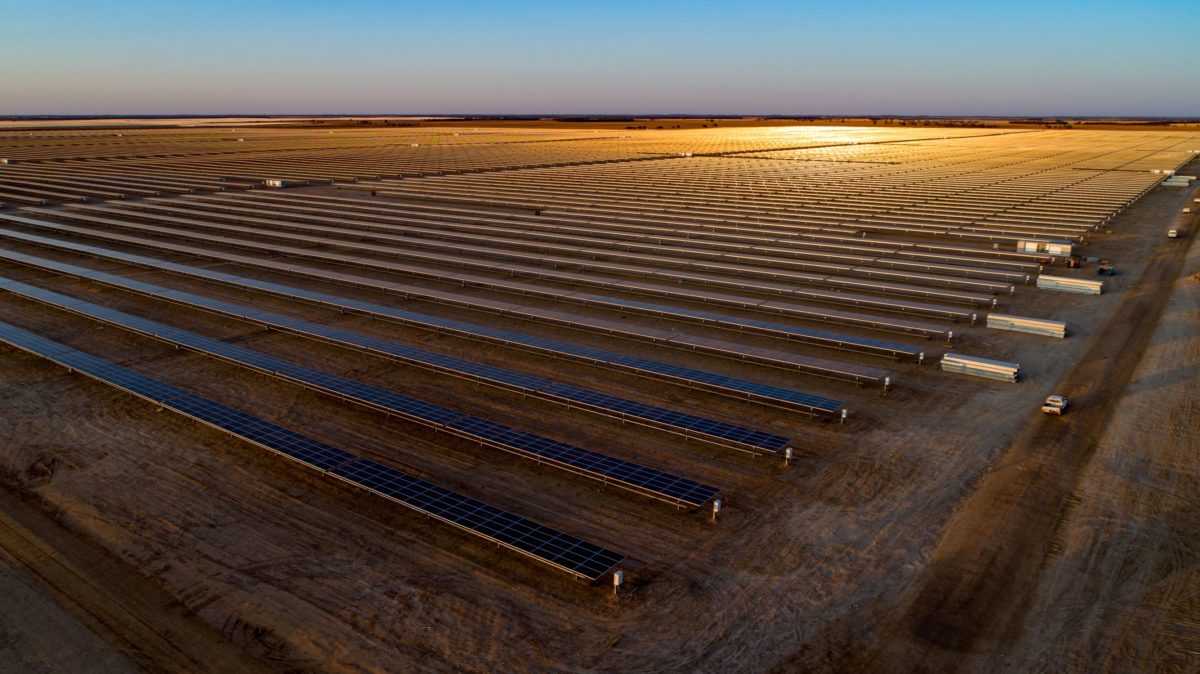Co-ordination and cohesion are the guiding principles of the Australian Energy Security Board’s Post 2025 Market Design Consultation Paper released this morning by ESB Independent Chair, Dr Kerry Schott. The proposed reforms are open to feedback from the public until 19 October 2020, and will be refined in line with responses, to be presented as recommendations to the country’s energy ministers by mid-2021.
A collaborative work of the ESB, the Australian Energy Market Commission (AEMC), the Australian Energy Regulator (AER) and the Australian Energy Market Operator (AEMO), the reforms are aimed at “systematically modernising the market design and regulatory frameworks to meet the needs of the energy transition”, an accompany statement said today.
“It’s a big agenda,” said Schott of the potential solutions, which are organised into seven categories:
- Resource Adequacy Mechanisms
- Aging Thermal Generation Strategy
- Essential System Services
- Ahead Mechanisms
- Two-sided Markets
- Distributed energy Resources (DER) Integration
- Transmission Access and the Coordination of Generation and Transmission
But she added, “The scale of the challenges mean it is imperative that this package be considered holistically. No reform will be left behind.”
The initiatives encompass virtually every aspect of how electricity is generated and dispatched, in tandem with how consumers will access services, and provides timely and efficient investment strategies designed to arrive at least-cost solutions.
“It is clear that the rules and market frameworks need to evolve to keep up with the accelerating pace of change” in the energy landscape, said Schott, “which is leading to security and reliability challenges and less than ideal outcomes for consumers”.
The paper seeks to address the fact that market participants and investors are poised to provide the services and resources needed to replace coal generation at scale over the coming two decades and maintain stability in the grid, but who rightly assert that “the current market is not ‘investable’” for these services.

Image: Energy Security Board
Decoupling system services from baseload power for greater value
Under the reforms labelled Essential System Services, the paper outlines the capabilities that have been provided as a byproduct of thermal generators, and which in a system powered by variable renewable generation will need to be provided separately but in step with generators that harness wind, sun and water.
Among these capabilities are inertia, system strength, reserve generation and rapidly responding frequency control services.
The ESB declares its preference “to move towards real-time markets for services where the system and technologies allow,” in order to provide clear price signals.
It also acknowledges that some services, such as system strength may be better suited to “structured procurement arrangements, such as TNSP provision, bilateral contracts between AEMO or NSPs and providers, and generator access standards or mandatory technical limits”.
Other options set out for discussion in this category include: development over the longer term of a co-optimised spot market for inertia; and exploration of how to incentivise primary frequency response in the NEM, ahead of the 2023 expiry of the requirement for generators to provide this capability as a condition of connection the National Electricity Market.
Establishing market mechanisms for such services will reduce and eventually negate the need for AEMO to intervene to stabilise the system or impose such responsibilities on generators, which the paper says results in “less efficient outcomes, inefficient investment signals, more complex operational decisions and higher costs to consumers”.
Each section of the paper progresses through context for the required reforms in that category, describes work carried out to date, and proposes staged changes to the current system.
Enabling an equitable and flexible two-sided market
In the section that seeks to enable two-sided markets and greater consumer participation in demand response and provision of services to the grid, the short term (two-year) objectives for establishing participation frameworks include:
- An expanded aggregator framework that would allow for easier aggregation of DER for participation in energy and FCAS markets.
- Consider the appropriate treatment of technical requirements for participating in central dispatch and forecasting processes and market interface requirements, e.g. the telemetry and communications requirements.
- Consider changes to the NEM to better integrate storage devices through rule change requests submitted to the AEMC.

Image: AEMO/ESB
Addressing transmission (code red)
On the all-important topic of Transmission Access and Coordination of Generation and Transmission, which will be critical to incorporating large quantities of renewable generation and storage into the grid over the coming two decades years, the paper refers to work by the AEMC to develop a model for reform with two core elements:
- Locational marginal pricing (LMP) – scheduled market participants would receive/pay a price that would more accurately reflect the value of supplying electricity at each location in the network and make the physical elements of the system more transparent.
- Financial transmission rights (FTRs) – these would allow participants to manage the risks of congestion by allowing them to purchase an FTR which would pay out on the differences in wholesale market prices arising due to congestion. Reforms are intended to support efficient and timely capital investment, efficient system operation and reduce costs to consumers.
Aggregating stakeholder thoughts on reform
Each section of the consultation paper also offers potential food for thought and further enquiry in the form of questions posed to stakeholders. They typically aim to link consideration of the proposed reforms to established plans such as AEMO’s Integrated System Plan (ISP) and the work in train by other agencies. For example, under Transmission Access, the paper asks:
- The second ISP has now been released. Do you have any comments on how its implementation can be made more efficient and timely?
- The development of REZs is important for the transition underway in the NEM. Do you have any suggestions on how large-scale priority REZs can be more efficiently developed and connect into the network?
- NERA Economic Consulting’s modelling of the benefits of introducing transmission access reform in the NEM has been published. What do you think about the modelling and assumptions used?
“We are very interested in feedback from all interest groups on the directions we have set out as we work toward a final set of recommendations,” said Schott.
She added that some changes will be implemented now, while others might spill beyond 2025: “This major reform is a change journey to and beyond 2025 — it is not a one ‘big bang’ reform process.”

Image: Energy Security Board
This content is protected by copyright and may not be reused. If you want to cooperate with us and would like to reuse some of our content, please contact: editors@pv-magazine.com.









By submitting this form you agree to pv magazine using your data for the purposes of publishing your comment.
Your personal data will only be disclosed or otherwise transmitted to third parties for the purposes of spam filtering or if this is necessary for technical maintenance of the website. Any other transfer to third parties will not take place unless this is justified on the basis of applicable data protection regulations or if pv magazine is legally obliged to do so.
You may revoke this consent at any time with effect for the future, in which case your personal data will be deleted immediately. Otherwise, your data will be deleted if pv magazine has processed your request or the purpose of data storage is fulfilled.
Further information on data privacy can be found in our Data Protection Policy.